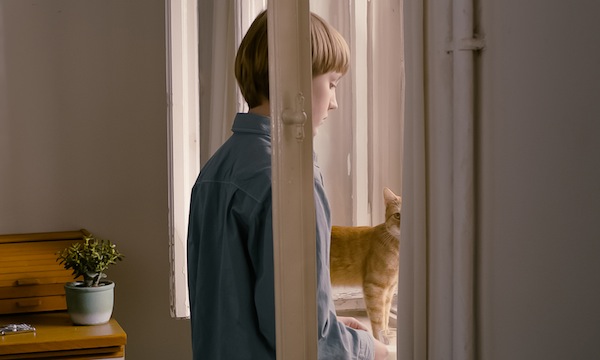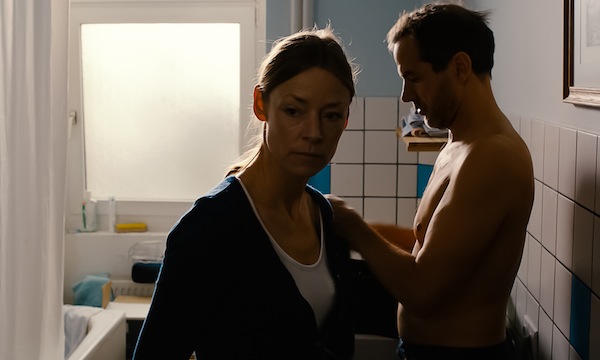The plot is minimalistic: Karin and Simon are visiting their parents and younger sister Clara; that evening the extended family reunites for a sit-down dinner. The choreography of their quotidian life, the intrusiveness of the soundscape, the claustrophobia of tight spaces, and objects that seem magically to spring to life, constitute the true content of this abstract cinematic meditation.
Experimental films, such as The Strange Little Cat, might be considered an acquired taste. Ramon admitted that the worst response he ever encountered in reaction to one of his films was from a commissioning editor who claimed that “he almost had a nervous breakdown while watching it.” Nonetheless, the Zürcher brothers are racking up notoriety at film festivals around the world; this past April, they were awarded the New Talent Grand Prize by CPH PIX (the Copenhagen International Film Festival, as merged with the NatFilm Festival). Film critics have compared The Strange Little Cat to work by masters such as Jacques Tati, Robert Bresson, and Ozu Yasujiro. The spirit of play and masterful control in establishing and maintaining an original cinematic universe and lexicon, is a strong foundation for a director-producer team, and portends good things to come from the duo.
I had an opportunity to speak with the Zürcher brothers in the filmmakers lounge at the San Francisco International Film Festival, where they were looking forward to introducing The Strange Little Cat to American audiences; to taking a Vertigo tour of San Francisco featuring stops where Hitchcock shot his film classic; and to attending screenings of Kiyoshi Kurosawa’s five-hour epic drama, Penance, and the documentary Leviathan from directors Lucien Castaing-Taylor and Verena Paravel.
When I inquired if they were identical twins, Ramon confessed that he believes so, but did not know for certain; “that would require a blood test,” he indicated. Curious indeed.
Sophia Stein: Ramon, you started out as a painter, and you call The Strange Little Cat, a piece of audiovisual sculpture. What do you mean by that?
Ramon Zürcher: A film often becomes a slave to a classical plot. What I think is really interesting, is media of moving images and audio that aren’t slaves to classical story structure. Sounds, for me, have a certain musical quality. My film is like a sculpture of sounds and movements. There may be classical elements, but I use the media, not in a classical way, to create a sound sculpture.
S2: Do you consider yourself a narrative filmmaker, or an experimental filmmaker, or beyond categorization?
RZ: I would say that I am a narrative filmmaker, but in an alternative way. I prefer the context of showing my work in the black box of the cinema, rather than in art galleries.
S2: There are a number of striking images in this film – my favorite being that little girl Clara, screaming from irritation and glee. Where did that image come from?
RZ: Clara, the little girl, was like the loud coffee machine for me. One of the first images that came to me was the cat scratching at the bedroom door, the sleeping man behind the closed door, and the mother watching the cat. That passive aggressive mother is like a composer of abstract music, letting those destructive, loud, sounds just be.
S2: Are you hyper-sensitive or hyper-aware of sound?
RZ: Maybe … last night, I couldn’t sleep because of the loud refrigerator in our hotel room. My brother slept. Me, I needed to find the source of that sound, and unplug it. When I write, I look at the actions of the human beings and certain themes emerge from the choreography.
S2: You used automatic writing to generate a 170-page first-draft of the screenplay. How did you go about cutting it down?
RZ: There were many, many monologues — too many monologues. In the finished film, there are around four, but in the original screenplay, there were eight or nine.
S2: Those monologues reminded me stylistically of monologues in the films of director Ingmar Bergman. Were you influenced by him at all?
RZ: Bergman’s films are like rooms to the interior psyches of human beings. That aspect, I adore. His films are a bit abstract. There is the aspect of self-destruction, of destruction of the body and blood in his movies. I like his fixation on pathologies or deformations, on characters that aren’t are completely sound. I like the crises. I like his profundity.
S2: The locations in your film are very claustrophobic, tight by design?
RZ: Yes, the design was to have the story take place in real time, with no one leaving the apartment — like a pressure-cooker, and never letting the pressure out. The only time the camera or the characters escape is during the monologues, and at noon and in the very end.
S2: At the beginning, the film struck me as funny. But as the film went on, that apartment became more and more oppressive. I realized that these characters were either passive-aggressive or blatantly aggressive to one another. You created a hostile universe, with an over-arching sense of suspense. It made me wonder if in your future, you will make thrillers or horror movies?
RZ: Of all the genres, I like most: horror, psycho-thrillers, and comedies. What would be interesting to me would be to mix up the language of the genres — using the language of the genres, and then breaking conventions, building up expectations and then undercutting them by taking things in an unexpected direction. Or letting some genres rub up against each other, to create a conflict of genres – for example, suddenly a comedy infringes upon a psycho-thriller; or the reverse, where it’s very funny and suddenly something absolutely horrible happens.
S2: You refer to the character of the mother in your film as “the queen of this particular realm.” She interrupts communication with that screaming mixer, for “a relay race of small humiliations and violent acts.”
RZ: The mother-child relationship became the heart of the movie while I was writing. She isn’t a mother in a classical sense. She’s a mother who doesn’t want to be a mother, or a mother who can’t be a mother. So it became about her perverted lack in this respect. I didn’t write it from a psychological perspective. I wanted to maintain some complexity, with this understanding as my secret.
S2: Are you familiar with Sartre’s play, No Exit (Huis Clos”), his premise being that hell is other people?
RZ: Ah, yes. Also an existential chamber piece. Like life! That’s interesting. I never thought about that before, but The Strange Little Cat has that aspect. The kitchen is the social room; then there are the other rooms, where the people can be asocial. It’s as if the social rooms become like hell, because in the social rooms, there can be veletzung — harm.
S2: You have described your intention: “I want to create a condensed universe in which the throwness of an absurd existence glimmers from behind everyday action and conversations, in which the difficulty of communicating experiences and feelings continually renews isolation.” What do you mean by “throwness”?
RZ: That existential aspect of being thrown into life, not knowing much about it, and, just having so many question marks?!
Silvan Zürcher: This term, “throwness” (“geworfen sein”) was coined by philosopher Martin Heidegger. But I don’t think Ramon meant it in this sense. I believe that Ramon meant, more or less, what Sartre and the other existentialists meant about being thrown into this arbitrary existence without being cognizant of how things are at the beginning, then watching and waiting to get a sense of what one can do.
S2: The Strange Little Cat began as a classroom assignment, in which you were challenged to loosely adapt Franz Kafka’s short story The Metamorphosis. Ramon, you have referred to your film as “an adaptation without constraints.” What elements did you take from Kafka’s original?
RZ: The first layer of the script canvas was Kafka. What I used from that layer was the kitchen (the social room where the family congregates), the bedroom (the asocial room where Gregor Samsa is lying down), and the presence of the animals. In The Metamorphosis, there is only the bug, but in The Strange Little Cat, there are many animals.
S2: How was it to direct the animals?
RZ: Funny! It was difficult enough to get all those characters together — to perform the correct actions, with the correct dialogue, at the correct moment, with emotions that were right; it was a very strict and controlled environment for the actors. The cat – we couldn’t direct her at all! So she improvised. The camera was fixed, and we waited (for hours sometimes) until she made an action that we could use in the movie. So it was kind of, a very nice meditation. There was an animal trainer for the dog, who classically conditioned desired behavior with food and commands. The dog wasn’t difficult at all; he did just what we wanted.
S2: You have these still life montages of objects, in the film. What inspired that idea?
RZ: The short movie that I made just prior to The Strange Little Cat was called was also a chamber piece; it was about young people living in a commune. As in this film, people performed actions and interacted with objects that didn’t initially seem important. After each scene, we focused on each object, as if it were important. We discovered that we had formed a connection to the objects because of the characters previous experiences with them. Showing the characters and the actions, and then just the objects — for me, this was a wonderful way of creating a structure, just as one might use a period to punctuate the end of a sentence; or as in music, where there is the refrain, followed by the chorus.
S2: There were really strange camera angles in this movie. Sometimes we are looking at people’s mid-sections, with their heads cut off. Can you talk about your approach?
RZ: We considered, what is the character of the camera?, and we decided that it was a lazy camera — a camera that is always late, as if it is a camera doesn’t know what will happen. In many movies, the camera always knows what will happen, so it always sees the right thing. We wanted a camera which doesn’t see the right things; a camera that doesn’t know what is important and what isn’t important, what makes sense and what does not make sense. It’s a confused camera.
S2: In his State of Cinema address, Soderbergh was talking about how we are all living in a state of present shock, where there is so much coming in, that we are unable to decipher the narrative. We literally don’t know where to look.
RZ: When we don’t know where to look, it becomes so complex — not only for the characters, but also for the camera. The absurdity of being thrown into an absurd life — when characters speak about this condition, it’s not interesting because that makes it seem so uncomplicated. To render that condition cinematically, requires making specific decisions about the camera.
The Strange Little Cat does not currently have a US theatrical release. We recommend this review by Michael Sicinski in Cinema Scope.
Photos: Top: Silvan and Ramon Zürcher, photographed by Pamela Gentile; below: two scenes from ‘The Strange Little Cat,’ photographed by Alexander Hasskerl. Photos courtesy San Francisco Film Society.


